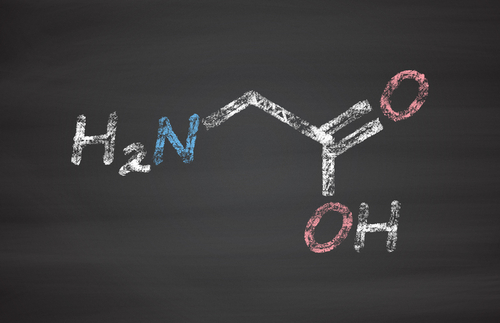5 Things You Didn’t Know About Glycine
Glycine is a non-essential amino acid primarily found in gelatin and silk fibroin. In Humans, it is the second most widespread amino acid found in enzymes and proteins with concentrations in the skin, muscle tissue and connective tissue. Abbreviated G or Gly, Glycene is biosynthesized in the liver from amino acids serine and threnine and can be taken in supplement form for many therapeutic benefits. Working in healthcare, I found the following 5 benefits particularly interesting.
Muscle Growth and Repair
Not just for the bodybuilder, but those recovering from surgery or injury. Glycine is used in the synthesis of creatine which is a direct energy source for muscles to growth and repair. It can be taken orally as pill form or applied directly on a wound using a glycerine cream. It has also been shown to prevent muscle degeneration, important for surgical patients recovering who are immobile.
Helps Prevent Hemorrhagic Shock
For the surgical patient or trauma victim that sustains significant blood loss, glycine protects against shock caused either by blood loss or endotoxin. Glycine reduces organ injury and mortality caused by hemorrhagic shock by preventing free radical production. Mitochondria are targeted in the brain cortex under hypoxic conditions and energy generation is preserved. This process is also significant for ischemic stroke and sleep apnea patients.
Blood Sugar Regulation
Glycine helps spare glucose for energy by improving glycogen storage. Oral glycine stimulates the secretion of a gut hormone that potentiates the effect of insulin on glucose removal from circulation. In addition, because it is naturally sweet it can be used as a sweetener in place of high sugar substitutes. Great news for the diabetic patient.
Treatment for Schizophrenia
When therapeutic levels of glycine is added to the treatment regime for schizophrenia, persistent negative and cognitive symptoms associated with the disease are diminished. It has also been shown to be effective in treating manic psychological states in the bipolar patient and is of therapeutic benefit to the patient with seizures associated with epilepsy.
Improves Sleep Quality
Glycine can cross the blood brain barrier and is believed to have an effect on NMDA receptors that cause paralysis during REM sleep. It also facilitates the lowering of core body temperature and normalization of circadian rhythms. For the Yogis out there, a pinch of glycine powder under the tongue can give immediate relief from “monkey mind,” a common complaint among insomnia sufferers.
As with any amino acid supplementation, it is important to limit the use to 6-8 weeks giving a 2-3 week break between repeat treatments to prevent imbalances. Be sure to speak with your doctor or health care professional before you start, stop, or change any prescribed part of your health care plan or treatment and to determine what course of therapy is right for you. Glycine with all its benefits does not come without risk to certain individuals.

References
DC, J. (n.d.). Nathan Kline Institute for Psychiatric Research, New York University School of Medicine, Orangeburg 10962, USA. Javitt@nid.rfmh.org. Retrieved August 07, 2017, from http://europepmc.org/abstract/med/12186269
De, T. J., Duran, M., Dorland, L., Gooskens, R., Van, E., Jaeken, J., . . . Poll-The, B. T. (1998, August). Beneficial effects of L-serine and glycine in the management of seizures in 3-phosphoglycerate dehydrogenase deficiency. Retrieved August 07, 2017, from https://www.ncbi.nlm.nih.gov/pubmed/9708551
Gannon, M. C., Nuttall, J. A., & Nuttall, F. Q. (2002, December). The metabolic response to ingested glycine. Retrieved August 07, 2017, from https://www.ncbi.nlm.nih.gov/pubmed/12450897
Glycine – Improving Sleep Quality. (n.d.). Retrieved August 07, 2017, from https://www.naturopathiccurrents.com/articles/glycine-improving-sleep-quality
Haas, E. M., & Levin, B. (2006).Staying healthy with nutrition: the complete guide to diet and nutritional medicine. Berkeley: Celestial Arts.
Matilla, B., Mauriz, J. L., Culebras, J. M., González-Gallego, J., & González, P. (n.d.). [Glycine: a cell-protecting anti-oxidant nutrient]. Retrieved August 07, 2017, from https://www.ncbi.nlm.nih.gov/pubmed/11939124
Selin et al. Mechanism underlying the protective effect of glycine in energetic disturbances in brain tissues under hypoxic conditions. Bull Exp Biol Med. 153(1):44-7 (2012).Matilla, B., Mauriz, J. L.,


